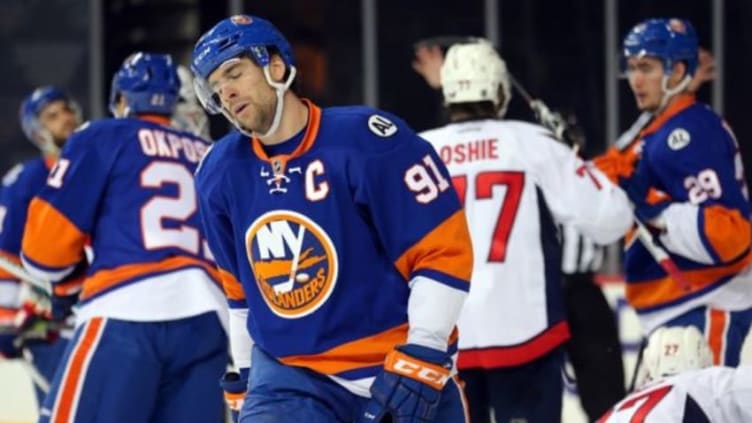New York Islanders Analysis: Isles’ Possession Numbers are Concerning

Halfway through a season in which the New York Islanders were expected to be a top team in the league, their possession numbers suggest they aren’t even close.
Related Story: Flyers Shutout the Isles 4-0
Despite a having half a season of games to evaluate, the Isles are very difficult to get a read on. The team didn’t achieve what they’d hoped to in the Stanley Cup Playoffs last season, but they played an entire regular season of elite-level hockey and put themselves in the conversation of Stanley-Cup contenders.
While little has changed in terms of the team’s construction, a lot has changed in their play.
Last season, the Isles controlled 53.6 percent off the score-adjusted shot attempts (Corsi), good for sixth in the league and third in the Eastern Conference. This year, they sit at 15th in the NHL with only 49.9 percent of the score-adjusted Corsi.
Outside of their even-strength play, things are basically the same. They are taking 1.2 less Corsi for per 60 (CF60) on the powerplay (2014-15 – 96.5, 2015-16 – 95.3) and allowing 3.6 less Corsi against per 60 (CA60) on the penalty kill (2014-15 – 103.8, 2015-16 – 100.2) – slightly better on the penalty kill and slightly worse on the powerplay.
It’s the team’s even-strength play that is really concerning.
More from Eyes On Isles
- Islanders key to success: Load management with goalies
- Islanders Zdeno Chara trending in the right direction
- Islanders: Semyon Varlamov Deserves Benefit of the Doubt
- Islanders Ilya Sorokin becoming number one goalie
- Islanders Zach Parise Was Quiet in Return to Minnesota
When broken down into shot attempts for and shot attempts against, things become a little clearer. Last season, the Isles CF60 was 61.4 and their CA60 was 54.4. This season, their CF60 is 55.5 and their CA60 is 57.1. Obviously, this season is worse, but the more significant of the two is the drop in CF60.
While both stats are equally important, the slight rise in CA60 could be due to the significant drop in CF60. After all there’s a reason the measurement for possession is framed as Corsi for – if you’re in your opponents end with the puck, they won’t be in yours.
So, why are the Islanders generating less offence?
The roster has stayed largely the same. Of players that played at least 20 games last season, only Lubomir Visnovsky and Michael Grabner have moved on. Visnovsky wasn’t re-signed in free agency and Grabner was traded to the Leafs for a handful of prospects at the beginning of the year. Visnovsky was an elite possession player, and Marek Zidlicky has failed to replace his level of play (just ask Thomas Hickey), but he mainly played third pairing minutes and the struggles are throughout the entire line-up this year.
Even when you look at each player individually, it’s not one player or one line struggling (Well, Brian Strait isn’t helping), instead every single player other than Frans Nielson and Travis Hamonic have seen their possession numbers drop:
For the top players on this list, most of the drop off is to due a significant drop in their CF60. A lack of offence has plauged the entire Islanders lineup and it’s difficult to say why. One or two players could be chalked up to a down season or an injury, but an entire team’s struggles suggests something more.
It’s difficult to put a coach that brought the Islanders to such a powerful position last season on the hot seat, but the only thing left to look at is Jack Capuano.
Whether it’s a lack of preparation and accountability or a change in the Islanders system, those responsibilities fall on the coach . There’s nothing conclusive to suggest that he is the problem, but that’s just the way the NHL works. Things start to go downhill and the first place everyone looks is the coach, especially with a roster built as well as this one.
In fact, the only thing keeping Capuano out of some fans’ social media cross-hairs (Although there are plenty of #FireCapuano tweets) is the play of his goalies. Jaroslav Halak and Thomas Greiss have stepped up this season, raising the Islanders’ save percentage from .903 in 2014-15 (26th) to .918 (9th) in 2015-16. However, the play of their goalies isn’t going to carry them forever.
Next: Ilya Sorokin Leading KHL in Save Percent
In the next few weeks, we’ll be trying to find differences in the systems from last year to this year, let us know if you’ve seen any differences yourself.
(Stats courtesy of waronice.com and puckon.net)